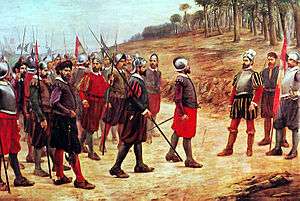Famous Thirteen

The Famous Thirteen (Spanish Los trece de la fama, "the thirteen of the fame", or Los trece de Gallo, "the thirteen of [Isla del] Gallo") were a group of 16th century Spanish conquistadors that participated in the Spanish conquest of Peru (second expedition) along with their leader, Francisco Pizarro. In 1527 Pizarro and his men were waiting on the Isla del Gallo, in bad conditions, when the supply ship returned from Panama with orders from the Spanish governor to abandon the expedition. According to the traditional version of the story, Pizarro drew a line in the sand with his sword and said, "those on that side of the line can go back to Panama and be poor; those on this side can come to Peru and be rich. Let the good Castillian choose his path." In the traditional telling of the story, only thirteen men chose to stay with Pizarro.[1]:26[2]
Historians have noted inconsistencies in reports of the identity of the Famous Thirteen, and have identified as many as nineteen candidates for the thirteen spots.[3][4]
One list of names is as follows:
- Nicolás de Ribera[5]:116 "el Viejo", born in Olvera, Andalucía;[6]:95
- Cristóbal de Peralta,[5]:116 hidalgo of Baeza;[6]:95
- Antón de Carrión,[5]:116 born in Carrión de los Condes;[6]:96
- Pedro de Candia,[5]:116 a Greek born in Candia, Crete;[6]:95
- Domingo de Soraluce,[5]:116 or Soria Lucina, a Basque merchant from Vergara[6]:95
- Francisco de Cuéllar,[5]:116 from Cuellar;[6]:95
- Joan de la Torre[5]:116 y Díaz Chacón, born in Villagarcía de la Torre de Extremadura, near Llerena;[6]:96
- Pedro de Alcón,[5]:116 from Cazalla de la Sierra north of Seville;[6]:96
- García de Jeréz[5]:116 or Jaren, Utrera merchant[6]:96
- Alonso de Briceño,[5]:116 born about 1506 in Benavente;[6]:96
- Alonso de Molina,[5]:116 born in Úbeda;[6]:95
- Gonzalo Martín de Trujillo, born in Trujillo;[6]:95
- Martín de Paz.[5]:116
Also, the "brave pilot" Bartolomé Ruiz.[5]:116
Aftermath
The Capitulation of 1529, made Ruiz Grand Pilot of the Southern Ocean, while Candia was placed at the head of artillery, and the remaining eleven "were created hildagos and cavalleros.[5]:134
See also
- The Nine Worthies are known in Spanish as los nueve de la fama.
References
- ↑ Hemming, J., 1970, The Conquest of the Incas, New York: Harcourt Brace Jovanovich, Inc., ISBN 0151225605
- ↑ Shannon Venable, Gold: A Cultural Encyclopedia: A Cultural Encyclopedia (ABC-CLIO, 2011), ISBN 978-0313384318, pp. 224-225. Excerpts available at Google Books.
- ↑ David P. Henige, Numbers from Nowhere: The American Indian Contact Population Debate (University of Oklahoma Press, 1998), ISBN 978-0806130446, p. 344 n.26. Excerpts available at Google Books.
- ↑ Clements Robert Markham, ed., Reports on the discovery of Peru (Hakluyt Society, 1872). Excerpts available at Google Books.
- 1 2 3 4 5 6 7 8 9 10 11 12 13 14 Prescott, W.H., 2011, The History of the Conquest of Peru, Digireads.com Publishing, ISBN 9781420941142
- 1 2 3 4 5 6 7 8 9 10 11 12 Leon, P., 1998, The Discovery and Conquest of Peru, Chronicles of the New World Encounter, edited and translated by Cook and Cook, Durham: Duke University Press, ISBN 9780822321460